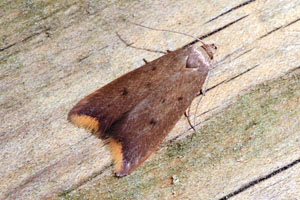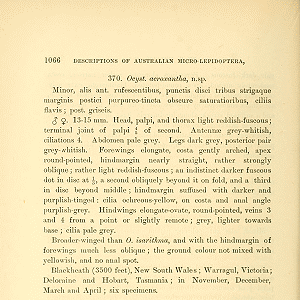Version 15 (neueste) vom 29. November 2023 um 22:02:29 von Erwin Rennwald
Länder:

 +3Kontinente:EUOC
+3Kontinente:EUOC


 +3Kontinente:EUOC
+3Kontinente:EUOCInhalt
1. Lebendfotos
1.1. Falter
1: Großbritannien, London, Wimbledon, 5. Mai 2016, am Licht (leg., det. & fot.: Vlad Proklov)Forum
2. Diagnose
2.1. Erstbeschreibung
1: Meyrick, E. (1885: 1066) [nach Copyright-freiem Scan auf www.biodiversitylibrary.org]
3. Weitere Informationen
3.1. Andere Kombinationen
- Ocystola acroxantha Meyrick, 1885 [Originalkombination]
3.2. Faunistik
Meyrick (1885: 1066) beschrieb die Art aus Australien: "Blackheath (3500 feet), New South Wales; Warragul, Victoria; Deloraine and Hobart, Tasmania ; in November, December, March and April ; six specimens."
Emmerson & Hoare (2019: 56) schrieben zur Art in Albany in Neuseeland, die sie als "adventive" einstuften: "Fairly common from September until May."
Nach der [Fauna Europaea] ist T. acroxantha in Europa nur aus Großbritannien nachgewiesen. Kimber teilt mit, dass die dort erstmals in Devon im Jahr 1908 dokumentierte Art vermutlich mit Pflanzenimporten aus Australien eingeschleppt wurde und sich seitdem nach Norden bis Lancashire ausgebreitet hat.
(Autor: Erwin Rennwald)
3.3. Literatur
- Emmerson, A. & R. Hoare (2019): Lepidoptera from Redvale, Albany, north of Auckland, New Zealand, 2004-2016: an annotated list. — The Weta, 53: 43-70. [/weta.ento.org.nz]
- Erstbeschreibung: Meyrick, E. (1885): Descriptions of Australian Micro-Lepidoptera. XII. Oecophoridae. — The Proceedings of the Linnean Society of New South Wales 9: 1045-1082. Sydney (F. Cunninghame & Co.). [Digitalisat auf archive.org]






